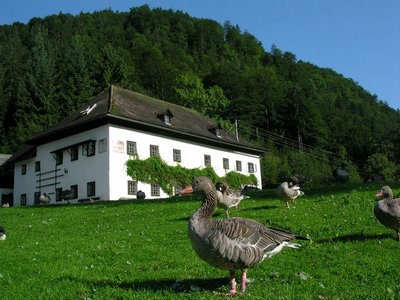The year of the Greylag geese
Seasonal behavioural differences of male and female Greylag geese (Anser anser) from different social categories
Pupils of the „Volksschule“ (Primary School, 6 to 10 y.o.) in Grünau im Almtal will be involved in the longterm data collection of the Konrad Lorenz Research Station (KLF) as well as in a small research project.
The KLF was founded in 1973 by Konrad Lorenz and dedicated itself to investigating the complexity of social systems and cognitive capabilities of Greylag geese (Anser anser) and other avian species. The goose flock currently consists of 150 individually marked individuals. The presence of the KLF offers children a worldwide unique opportunity to conduct scientific work with semi-feral animals.
The project consists of three parts:
1. Becoming familiar with the flock of Greylag geese. This will be achieved by utilising the KLF’s "goose list”, where all geese are tabulated by name and ring combination, as well as coloured illustrations of ringing combinations, which should facilitate the learning and understanding of the ringing system of the flock. This will allow the children to control the presence of each goose regularly. The pupils will in part take over this task, which usually is conducted by the staff of the KLF. This data collection represents one of the most important records of the KLF as it documents the development of Greylag goose population.
2. Ethogram of the Greylag goose. An ethogram lists and describes all discrete behaviours and serves as a preparation for the research project. It allows the pupils to define and recognize different behaviours. Again, the children will obtain pictures of the behaviours as auxiliary materials.
3. Research project. Focal animals will be assigned to the children in order to monitor their behaviour. A total of 42 males and females of different social categories (pairs, families, singletons, young) will be considered. Children will recorded the following behaviours: aggressive behaviour in different intensities, vigilance or status-signalling, courting, feeding, comfort and resting behavior. Behavioural frequency and duration will be noted as measurable and analysable parameters in 10-minute observation protocols. In order to determine seasonal differences, data will be taken during the following periods: autumn (Oct.-Nov.), winter (Dec.-Feb.), spring (March-May), summer (June-July).
The results will be published in an appropriate scientific journal as well as during an exhibition in the school.
This project is already completed.
Publikation
-
In: International Journal for Cross-Disciplinary Subjects in Education -IJCDSE, 3 (4):871-876
-
FRIGERIO, D./HEMETSBERGER, J./KOTRSCHAL, K. (2014): Selbst nach 40 Jahren Forschung: Neues von den Grünauer Graugänsen (Opens in new window)ÖKO L 36/1 (2014): 3-13 (PDF, 847 KB)
-
FRIGERIO, D./GEGENDORFER, G. (2013): Exotisch oder heimisch? – Der Waldrapp aus dem Almtal (Opens in new window)ÖKO L 35/3 (2013): 3-13 (PDF, 3 MB)

